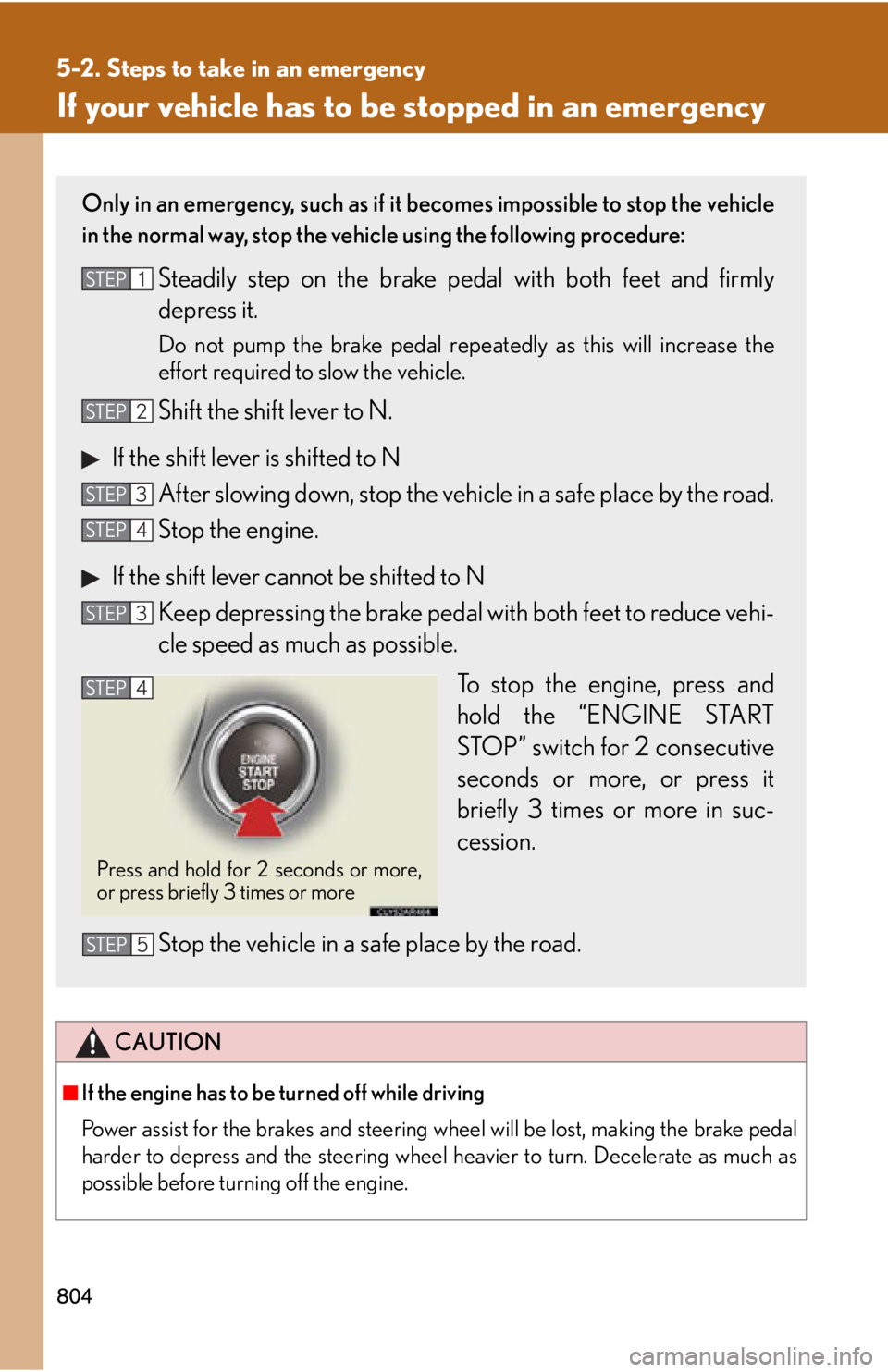Page 803 of 886
5
When trouble arises
8035-2. Steps to take in an emergency
■
When it is difficult to free the vehicle
CAUTION■
When attempting to free a stuck vehicle
If you choose to push the vehicle back and forth to free it, make sure the surround-
ing area is clear to avoid st riking other vehicl es, objects or people. The vehicle may
also lunge forward or lunge back sudden ly as it becomes free. Use extreme cau-
tion.■
When shifting the shift lever
Be careful not to shift the shift lever with the accelerator pedal depressed.
This may lead to unexpected rapid acceleration of the vehicle that may cause an
accident resulting in death or serious injury.
NOTICE■
To avoid damage to the tran smission and other components●
Avoid spinning the front wheels and depressing the accelerator pedal more than
necessary.
●
If the vehicle remains stuck even after these procedures are performed, the vehi-
cle may require towing to be freed. Press the VSC off switch to turn off TRAC.
Page 804 of 886

8045-2. Steps to take in an emergency
If your vehicle has to be stopped in an emergency
CAUTION
■
If the engine has to be turned off while driving
Power assist for the brakes and steering wh eel will be lost, making the brake pedal
harder to depress and the steering wheel heavier to turn. Decelerate as much as
possible before turning off the engine.Only in an emergency, such as if it becomes impossible to stop the vehicle
in the normal way, stop the vehicle using the following procedure:
Steadily step on the brake pe dal with both feet and firmly
depress it. Do not pump the brake pedal repeatedly as this will increase the
effort required to slow the vehicle.
Shift the shift lever to N.
If the shift lever is shifted to N
After slowing down, stop the vehicl e in a safe place by the road.
Stop the engine.
If the shift lever cannot be shifted to N
Keep depressing the brake pedal with both feet to reduce vehi-
cle speed as much as possible.
To stop the engine, press and
hold the “ENGINE START
STOP” switch for 2 consecutive
seconds or more, or press it
briefly 3 times or more in suc-
cession.
Stop the vehicle in a safe place by the road.STEP 1
STEP 2
STEP 3
STEP 4
STEP 3
STEP 4
Press and hold for 2 seconds or more,
or press briefly 3 times or more
STEP 5
Page 808 of 886
8066-1. Specifications
Maintenance data (fue l, oil level, etc.)Dimensions and weight
* 1
: Unladen vehicles
* 2
: Vehicles without roof antenna and roof rails
* 3
: Vehicles with roof antenna but without roof rails
* 4
: Vehicles with roof rails
* 5
: Without towing package
* 6
: With towing packageOverall length 187.8 in. (4770 mm)
Overall width 74.2 in. (1885 mm)
Overall height
* 1
66.3 in. (1685 mm)
* 2
66.7 in. (1695 mm)
* 3
67.9 in. (1725 mm)
* 4
Wheelbase 107.9 in. (2740 mm)
Tr e a d Front 64.2 in. (1630 mm)
Rear 64.0 in. (1625 mm)
Vehicle capacity weight
(Occupants + luggage) 885 lb. (400 kg)
Trailer Weight Rating
(trailer weight + cargo weight) 2000 lb. (907 kg)
* 5
3500 lb. (1588 kg)
* 6
Page 817 of 886
8156-1. Specifications
6
Vehicle specifications Tires and wheels
Type A
Type BTi r e s i z e P235/60R18 102V, T165/90D18 107M (spare)
Tire inflation pressure
(recommended cold tire
inflation pressure) Driving under normal conditions
Front:
32 psi (220 kPa, 2.2 kgf/cm 2
or bar)
Rear:
32 psi (220 kPa, 2.2 kgf/cm 2
or bar)
Spare:
60 psi (420 kPa, 4.2 kgf/cm 2
or bar)
Wheel size 18 7 1 /2J, 18 4T (spare)
Wheel nut torque 76 ft•lbf (103 N•m, 10.5 kgf•m)
Ti r e s i z e P235/60R18 102V
Tire inflation pressure
(recommended cold tire
inflation pressure) Driving under normal conditions
Front:
32 psi (220 kPa, 2.2 kgf/cm 2
or bar)
Rear:
32 psi (220 kPa, 2.2 kgf/cm 2
or bar)
Spare:
32 psi (220 kPa, 2.2 kgf/cm 2
or bar)
Wheel size 18 7 1 /2J
Wheel nut torque 76 ft•lbf (103 N•m, 10.5 kgf•m)
Page 818 of 886

8166-1. Specifications
Ty p e C
Ty p e DTi r e s i z e P235/55R19 101V, T165/90D18 107M (spare)
Tire inflation pressure
(recommended cold tire
inflation pressure) Driving under normal conditions
Front: 32 psi (220 kPa, 2.2 kgf/cm 2
or bar)*
Rear: 32 psi (220 kPa, 2.2 kgf/cm 2
or bar)*
Spare: 60 psi (420 kPa, 4.2 kgf/cm 2
or bar)*: When driving at high speeds above 100 mph (160
km/h), in countries where such speeds are permitted
by law, add 1 psi (10 kPa, 0.1 kgf/cm 2
or bar) to the
front tires, 3 psi (20 kPa, 0.2 kgf/cm 2
or bar) to the
rear tires. Never exceed the maximum cold tire infla-
tion pressure indicated on the tire sidewall.
Wheel size 19 7 1 /2J, 18 4T (spare)
Wheel nut torque 76 ft•lbf (103 N•m, 10.5 kgf•m)
Ti r e s i z e P235/55R19 101V
Tire inflation pressure
(recommended cold tire
inflation pressure) Driving under normal conditions
Front: 32 psi (220 kPa, 2.2 kgf/cm 2
or bar)
Rear: 32 psi (220 kPa, 2.2 kgf/cm 2
or bar)
Spare: 32 psi (220 kPa, 2.2 kgf/cm 2
or bar)
When driving at high speeds above 100 mph (160 km/h),
in countries where such speeds are permitted by law, add
1 psi (10 kPa, 0.1 kgf/cm 2
or bar) to the front tires, 3 psi
(20 kPa, 0.2 kgf/cm 2
or bar) to the rear tires. Never
exceed the maximum cold tire inflation pressure indi-
cated on the tire sidewall.
Wheel size 19 7 1 /2J
Wheel nut torque 76 ft•lbf (103 N•m, 10.5 kgf•m)
Page 826 of 886
8246-1. Specifications
Tire size
■ Typical tire size information
The illustration indicates typical
tire size.
Ti r e u s e
(P = Passenger car,
T = Temporary use)
Section width (millimeters)
Aspect ratio
(tire height to section width)
Tire construction code
(R = Radial, D = Diagonal)
Wheel diameter (inches)
Load index (2 digits or 3 digits)
Speed symbol
(alphabet with one letter)
■ Tire dimensions
Section width
Ti r e h e i g h t
Wheel diameter
Page 829 of 886

8276-1. Specifications
6
Vehicle specifications ■ Temperature A, B, C
The temperature grades are A (the hi ghest), B, and C, representing
the tire's resistance to the generation of heat and its ability to dissipate
heat when tested under controlled conditions on a specified indoor
laboratory test wheel. Sustained high temperature can cause the material of the tire to degenerate
and reduce tire life, and excessive temperature can lead to sudden tire fail-
ure.
The grade C corresponds to a level of performance which all passenger car
tires must meet under the Federal Mo tor Vehicle Safety Standard No. 109.
Grades B and A represent higher levels of performance on the laboratory
test wheel than the minimum required by law.
Warning: The temperature grades for this tire are established for a tire that
is properly inflated and not overloaded.
Excessive speed, underinflation, or excess ive loading, either separately or in
combination, can cause heat build up and possible tire failure.
Page 831 of 886

8296-1. Specifications
6
Vehicle specifications Tire related term Meaning
Occupant distribution Distribution of occupants in a vehicle as specified in
the third column of Table 1
* below
Production options
weight The combined weight of installed regular production
options weighing over 5 lb. (2.3 kg) in excess of the
standard items which they replace, not previously
considered in curb weight or accessory weight,
including heavy duty brakes, ride levelers, roof rack,
heavy duty battery, and special trim
Rim A metal support for a tire or a tire and tube assembly
upon which the tire beads are seated
Rim diameter
(Wheel diameter) Nominal diameter of the bead seat
Rim size designation Rim diameter and width
Rim type designation The industry manufacturer's designation for a rim by
style or code
Rim width Nominal distance between rim flanges
Vehicle capacity weight
(Total load capacity) The rated cargo and luggage load plus 150 lb. (68
kg) times the vehicle's designated seating capacity
Vehicle maximum load on
the tire The load on an individual tire that is determined by
distributing to each axle its share of the maximum
loaded vehicle weight, and dividing by two
Vehicle normal load on
the tire The load on an individual tire that is determined by
distributing to each axle its share of curb weight,
accessory weight, and normal occupant weight (dis-
tributed in accordance with Table 1
* below), and
dividing by two
We a t h e r s i d e The surface area of the rim not covered by the
inflated tire